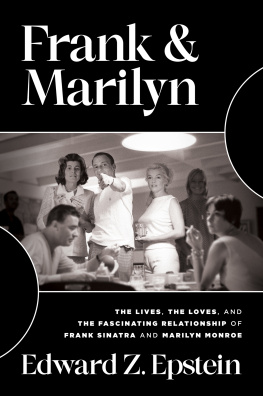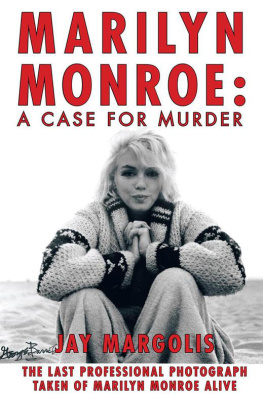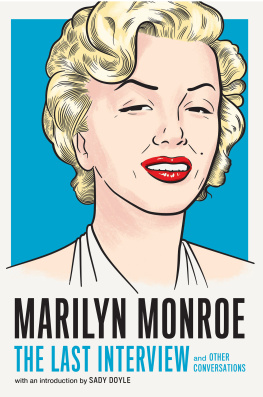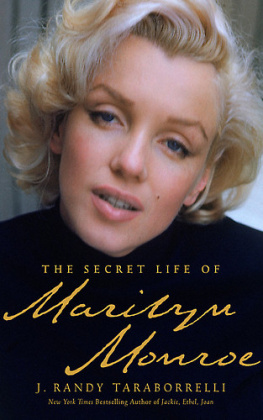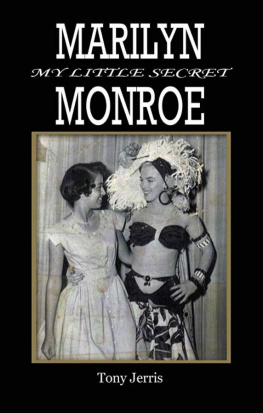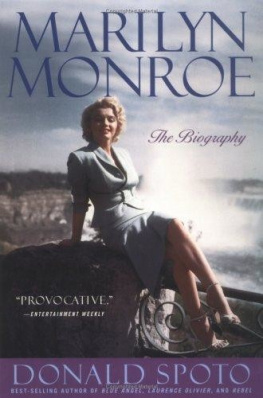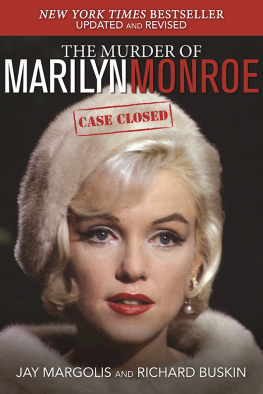Lothar Schirmer - Marilyn Monroe and the Camera
Here you can read online Lothar Schirmer - Marilyn Monroe and the Camera full text of the book (entire story) in english for free. Download pdf and epub, get meaning, cover and reviews about this ebook. year: 1989, publisher: ePubLibre, genre: Non-fiction. Description of the work, (preface) as well as reviews are available. Best literature library LitArk.com created for fans of good reading and offers a wide selection of genres:
Romance novel
Science fiction
Adventure
Detective
Science
History
Home and family
Prose
Art
Politics
Computer
Non-fiction
Religion
Business
Children
Humor
Choose a favorite category and find really read worthwhile books. Enjoy immersion in the world of imagination, feel the emotions of the characters or learn something new for yourself, make an fascinating discovery.
- Book:Marilyn Monroe and the Camera
- Author:
- Publisher:ePubLibre
- Genre:
- Year:1989
- Rating:3 / 5
- Favourites:Add to favourites
- Your mark:
- 60
- 1
- 2
- 3
- 4
- 5
Marilyn Monroe and the Camera: summary, description and annotation
We offer to read an annotation, description, summary or preface (depends on what the author of the book "Marilyn Monroe and the Camera" wrote himself). If you haven't found the necessary information about the book — write in the comments, we will try to find it.
Marilyn Monroe and the Camera — read online for free the complete book (whole text) full work
Below is the text of the book, divided by pages. System saving the place of the last page read, allows you to conveniently read the book "Marilyn Monroe and the Camera" online for free, without having to search again every time where you left off. Put a bookmark, and you can go to the page where you finished reading at any time.
Font size:
Interval:
Bookmark:
Many people and friends have contributed to making this project possible. I especially wish to thank Maria Hnigschmied, Carol Judy Leslie, Susanne Porsche, Hanna Schygulla, Cindy Sherman, and Bert Stern, who have all helped in their own ways to bring the idea behind this book to fulfillment. For help in the acquisition of the pictures as well as for contributions, hints and helpful support, I wish to thank Sid Avery, Susann Babst, Katherine Bang, Georges Belmont, Susan Bernard, Christiane Btzl, Dieter Boldt, Jean-Pierre Boscq, Leo Caloia, Debra Cohen, Simon Crocker, Lydia Cullen, Nancy DAntonio, Henri Dauman, Nancy M. Davis, Shirley de Dienes, Nora and Alex Ester, Jackie Fixot, John Florea, Alexander Haas, Yvonne Halsman, Franois Hbel, Elisabeth Heidt, Stevie Holland, Ken Johnston, Tom Kelley, Jr., David Kent, Margot Klingsporn, John Kobal, Hilaneh von Kories, Ned Leavitt, Renate Lust, Anne de Margerie, Michael Ochs, Onur Olgun, Randall Riese, Nicole Rudschinat, Uschi Sandvoss, Peter Schnug, Ina Seibold, David Seidner, Marcia Terrones, Johanna Thorman, Peter Tomlinson, Annemarie Weber, Ray Whelam, Bob Willoughby, Sue Wookey. Finally I should like to warmly thank all the contributing photographers and Miss Jane Russell for generously contributing a lively foreword to the book.
Munich, Autumn 1989
Lothar Schirmer
Arnold, Eve. Marilyn Monroe: An Appreciation. New York: Alfred A. Knopf, 1987.
Bernard of Hollywood. Requiem for Marilyn. Buckinghamshire: Kensal Press, 1986.
Conway, Michael, and Mark Ricci. The Films of Marilyn Monroe. With a Tribute by Lee Strasberg and an Introductory Essay by Mark Harris. New York: Citadel Press, 1964.
Crown, Lawrence. Marilyn at Twentieth Century-Fox. London: Planet Books, 1987.
de Dienes, Andr. Marilyn Mon Amour. Munchen: Schirmer/ Mosel, 1986.
Fahey, David, and Linda Rich. Masters of Starlight. Photographers in Hollywood. Los Angeles: Los Angeles County Museum of Art, 1987.
Halsmann: Portraits (Selected and edited by Yvonne Halsman). New York: McGraw-Hill Company, 1983.
Mailer, Norman. Marilyn. New York: Grosset & Dunlap, 1973.
Miller, Arthur. Timebends. New York: Grove Press, Inc., 1987.
Monroe, Marilyn. My Story. London: W. A. Allen, 1975.
Riese, Randall, and Neal Hitchens. The Unabridged Marilyn: Her Life from A to Z. New York/Chicago: Congdon & Weed, 1987.
Shevey, Sandra. The Marilyn Scandal. Her True Life Revealed by Those Who Knew Her. New York: William Morrow, 1987.
Spada, James, and George Zeno. Monroe. New York: Doubleday, 1982.
Stern, Bert. Marilyn Monroe: The Complete Last Sitting. Munchen: Schirmer/Mosel, 1982.
Summers, Anthony. Goddess: The Secret Lives of Marilyn Monroe. London: Victor Gollancz Ltd., 1985.
June 1, 1926. Marilyn Monroe is born in Los Angeles General Hospital, the third child of Gladys Pearl Baker, ne Monroe (May 25, 1900 March 11, 1984). She is named Norma Jeane (later Marilyn often left off the e in Jeane). The father remains unknown. The name Edward Mortensen is given on her birth certificate, since Gladys was married to a man of this name two years before the birth. Although Marilyn often uses this name for official documents, in numerous private conversations she denies that he was her real father. In one interview Marilyn mentions that her real father lived in the same apartment building as her mother did and that he left her during the pregnancy. This reference led to a man named Stanley Gifford, who worked for Consolidated Film Industries, where Marilyns mother was employed as a cutter. Rumors have it that Gifford was Gladyss lover when her second marriage with Mortenson broke up. In 1962, the year of her death, Marilyn gives the name of her father as unknown on an official questionnaire.
January 1935. Norma Jeanes mother goes into a deep depression and is sent to Los Angeles General Hospital; diagnosed as a paranoid schizophrenic, she is later committed to Norwalk State Asylum. Gladyss best friend, Grace McKee, is declared Norma Jeanes guardian. Gladys, who lives alone, on September 9, 1935, takes the young Norma Jeane to the orphanage of the Los Angeles Orphans Home Society.
June 26, 1937. Grace McKee marries Doc Goddard and time and again takes in Norma Jeane. In the following years Norma Jeane lives with many different foster families (who urgently need the five-dollar-a-week government allowance), spends two years in an orphanage, afterward is again in foster care, and finally lives for four years alone under an officially appointed guardian.
June 19, 1942. On a Friday, Norma Jeane Baker marries Jim Dougherty. The marriage was arranged by Grace Goddard because she and her husband were moving east and didnt want to take Norma Jeane with them. Jim Dougherty, a neighbors son, is taken completely by surprise when he hears that he is to marry the pretty Norma Jeane. A talented football player, he decided not to go to college and first worked as an embalmer in a mortuary, later as a mechanic for Lockheed Aviation. The marriage is scheduled for June, after Norma Jeanes sixteenth birthday. No honeymoon is possible: Monday morning Jim returns to work at the airplane factory. In fall 1943 Jim joins the Merchant Marine and spends most of his marriage as a soldier abroad.
June 26, 1945. David Conover, an army photographer for a military film unit, takes pictures of Norma Jeane for Yank, an army magazine. His task, which his commanding officer, later U. S. President Ronald Reagan, had given him, was to take morally uplifting snapshots of pretty girls working on jobs vital to the war effort. At this time Norma Jeane is earning twenty dollars a week at Radio Plane Corporation for ten hours work a day. The offer to earn five dollars an hour as a model comes at just the right time, and she continues to work as a freelance model. David Conover offers some of her photos to the model agency Blue Book, 4 nd recommends her to them.
August 2, 1945. The name Norma Jeane Dougherty is placed in the files of the Blue Book Modelling Agency; this marks the beginning of Norma Jeanes phenomenal career as a cover girl and sex symbol. From now on she can talk only about her meteoric success, and this estranges her husband, who is at home only for a few weeks at a time. The well-known photographer Andr de Dienes courts the lonely young woman and wants to marry her. Although she poses for him extensively and goes on a photo excursion with him, which ends in an affair, she withdraws and turns her attention to other men. Her work with other famous Hollywood photographers such as Lazio Willinger, Richard C. Miller, Earl Moran, Bruno Bernard, George Hurrel, and others begins to flourish. Her pictures soon appear on the covers of various magazines. This publicity leads to her first contact with the film world.
July 17 1946. Marilyn has her first audition with Ben Lyon, her discoverer, at 20th Century-Fox.
July 19, 1946. On the recommendation of Ben Lyon Norma Jeane is given her first film test at the 20th Century-Fox studios. His encounter with her convinces him of her talent and charisma, and he wants to put her under contract in spite of the reservations of Darryl Zanuck, head of 20th Century-Fox.
July 29, 1946. For the first time Norma Jeane Dougherty is mentioned in a Los Angeles Times gossip column.
August 24, 1946. Norma Jeane obtains her first studio contract with 20th Century-Fox. Ben Lyon finds the name Norma Jeane Dougherty completely inappropriate and calls her at first Carole Lind and then Marilyn Miller. Finally, Norma Jeane recalls the name of her grandmother, and she and Lyon agree to the pleasing alliteration of Marilyn Monroe. Years later, having achieved stardom, Marilyn sends Lyon a photo portrait with the dedication You found me, named me and believed in me when no one else did. My love and thanks forever.
Font size:
Interval:
Bookmark:
Similar books «Marilyn Monroe and the Camera»
Look at similar books to Marilyn Monroe and the Camera. We have selected literature similar in name and meaning in the hope of providing readers with more options to find new, interesting, not yet read works.
Discussion, reviews of the book Marilyn Monroe and the Camera and just readers' own opinions. Leave your comments, write what you think about the work, its meaning or the main characters. Specify what exactly you liked and what you didn't like, and why you think so.



